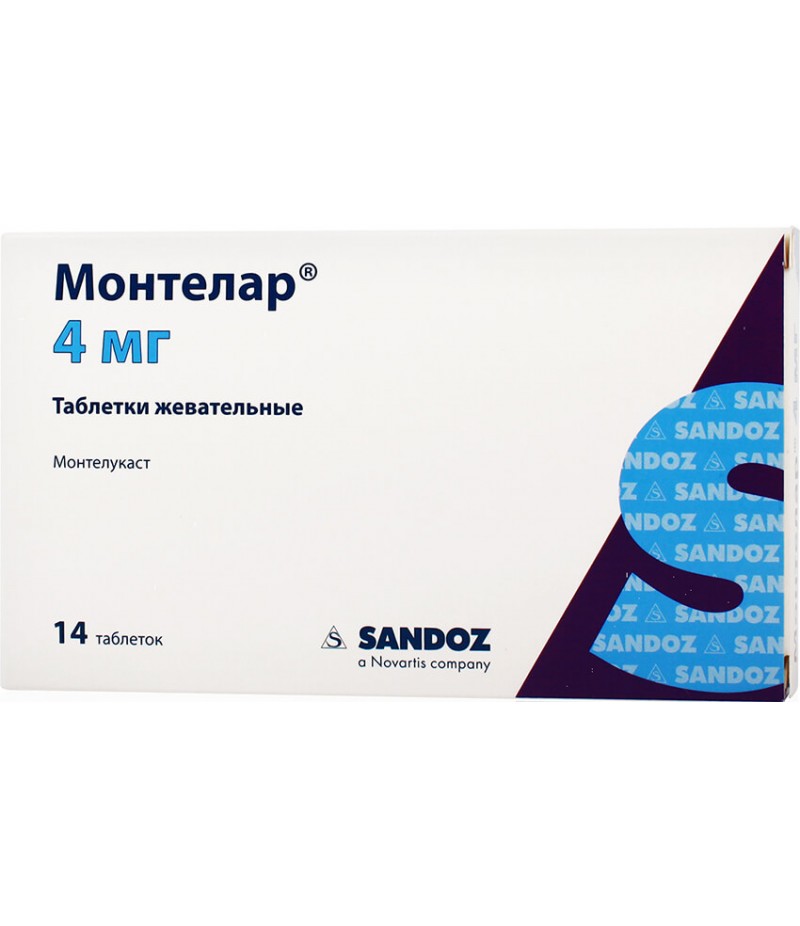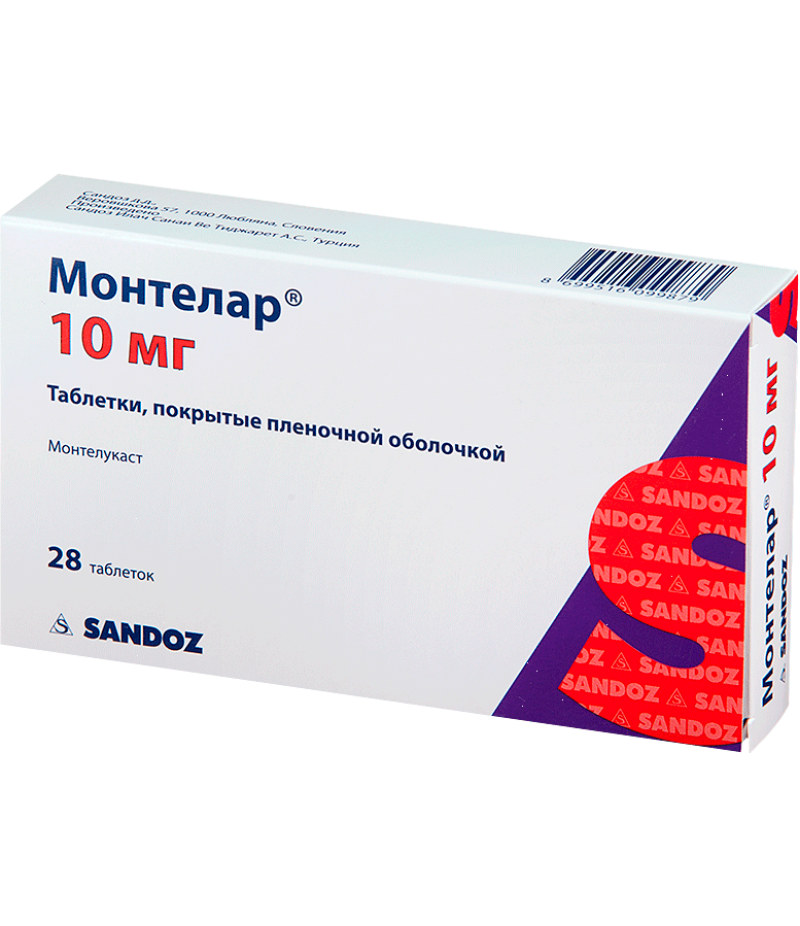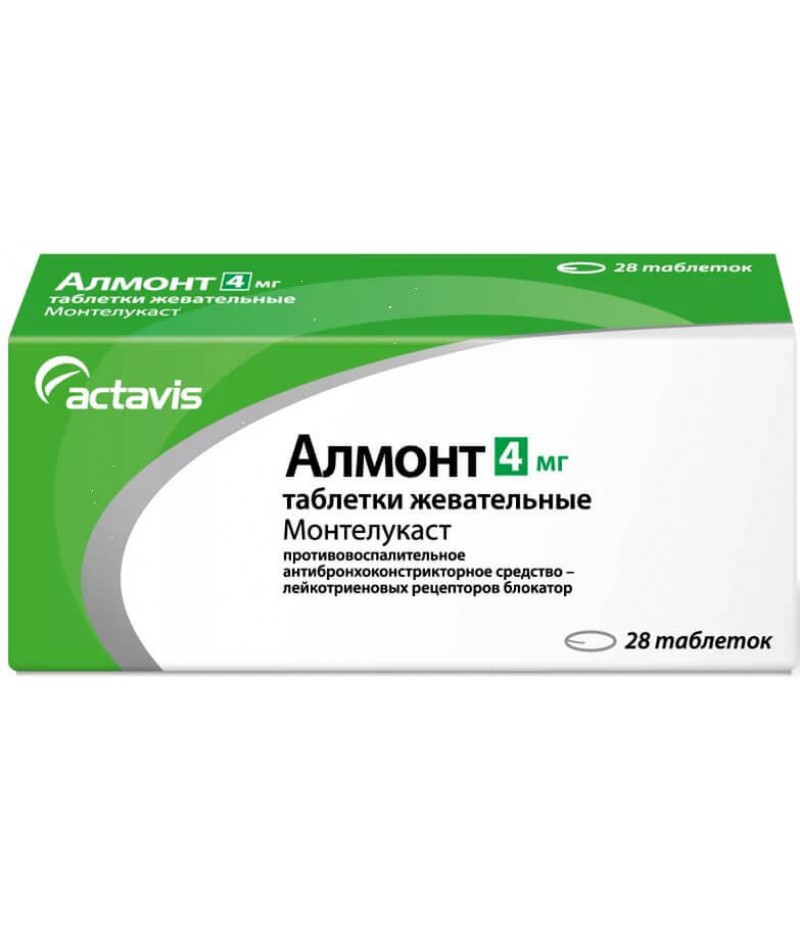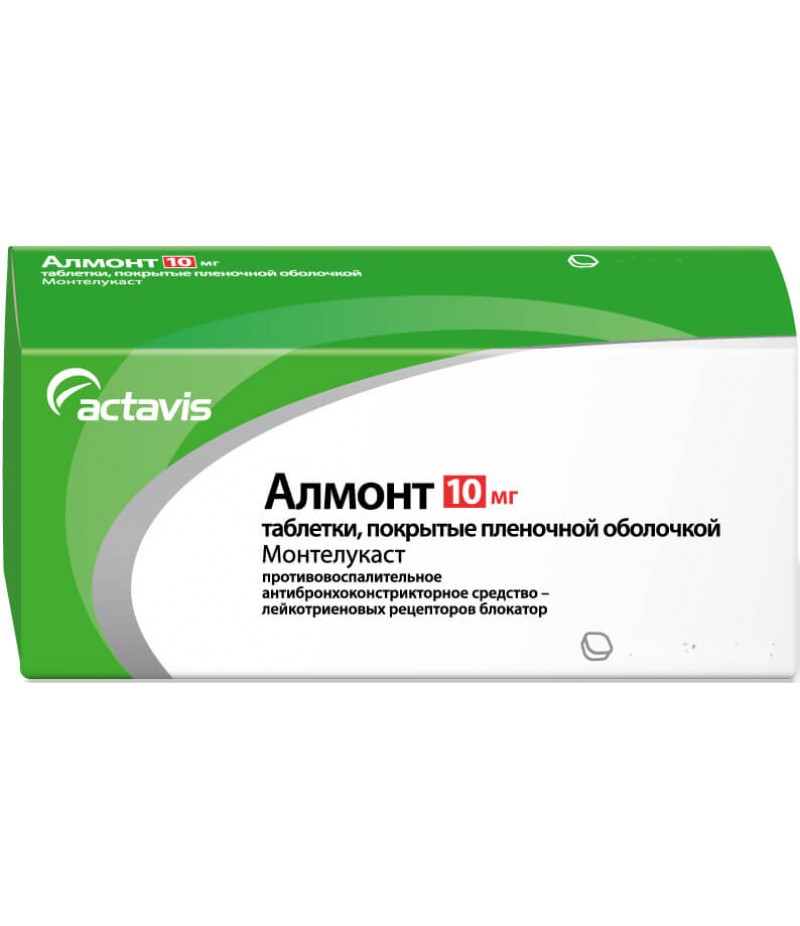Montelar tabs 4mg #28
- $42.30
- 2 or more $41.20
- 3 or more $39.99
- Availability:In Stock
Montelar instruction for useReed more and buy Montelar on this pageComposition1 chewable tablet contains: active substance: montelukast sodium - 4.16 mg (corresponds to montelukastu - 4.00 mg); auxiliary substances: mannitol 155.9..
Tags: tabs
Montelar instruction for use
Reed more and buy Montelar on this page
Composition
1 chewable tablet contains: active substance: montelukast sodium - 4.16 mg (corresponds to montelukastu - 4.00 mg); auxiliary substances: mannitol 155.92 mg, cellulose microcrystalline 52.80 mg, croscarmellose sodium 12.00 mg, giprolose, type EXF 7.20 mg, cherry flavor * 1.92 mg, aspartame 0.96 mg, cherry flavor 0 , 48 mg, iron (III) dye red oxide 0.36 mg, magnesium stearate 4.20 mg.
Description
Tablets 4 mg: oval tablets are pink in color with numerous darker patches, marked "4" on one side, with a cherry smell.
Pharmacotherapeutic group
Anti-inflammatory anti-bronchoconstrictive means - leukotriene receptor blocker.
ATX Code: RO3DCO3
Pharmacological properties of Montelar
Pharmacodynamics
The blocker of cysteinyl leukotriene receptors of respiratory tract epithelium CysLT1 (leukotrienes C4, D4 and E4 - mediators of chronic persistent inflammation, supporting bronchial hyperreactivity in bronchial asthma). Prevents excessive formation of secretions in the bronchi, swelling of the mucous membrane of the respiratory tract. Reduces the severity of the course of bronchial asthma and the frequency of asthmatic attacks. Highly effective at ingestion.
Bronchodilator effect develops within 1 day and persists for a long time.
Pharmacokinetics
Suction
Montelukast quickly and almost completely absorbed after ingestion from the gastrointestinal tract (GIT). Bioavailability for tablets 5 mg when taken orally is 73%.
After taking chewable 4 and 5 mg tablets, the time to reach the maximum concentration (TCmax) is 2 hours.
Distribution and Metabolism
Montelukast binds to plasma proteins more than 99%. The average volume distribution of Montelukast averages 8-11 liters.
Montelukast is actively metabolized in the liver. When using therapeutic doses, the concentration of metabolites of montelukast in plasma in equilibrium in adults and children is not determined.
It is assumed that cytochrome P450 isoenzymes (3A4 and 2C9) are involved in the metabolism of montelukast, while in therapeutic concentrations, montelukast does not inhibit CYP isoenzymes: 3A4, 2C9, 1A2, 2A6, 2C19 and 2D6.
Excretion
Plasma clearance - 45 ml / min. After oral administration, montelukast is almost completely excreted through the intestine (about 86%) and less than 0.2% by the kidneys.
The half-life of montelukast (T1 / 2) in young healthy adults ranges from 2.7 to 5.5 hours.
Pharmacokinetics in special cases
The pharmacokinetics of montelukast in women and men has a similar character.
There is no need to adjust the dosage regimen for elderly patients and for patients with mild to moderate hepatic impairment.
Since montelukast and its metabolites are excreted through the intestine, there is no need for dose adjustments for patients with renal insufficiency.
Indications for use
Prophylaxis and long-term treatment of bronchial asthma in children, including:
• Prevention of day and night symptoms of the disease (for children from 2 years of age and older);
• treatment of bronchial asthma in patients with hypersensitivity to acetylsalicylic acid (for children 6 years and older);
• Prevention of bronchospasm caused by physical exertion (for children from 2 years and older).
Relief of seasonal and allergic rhinitis symptoms in children aged 2 years and older.
Contraindications for Montelar
• Hypersensitivity to any of the components of Montelar;
• Children's age up to 2 years (for a dosage of 4 mg) and up to 6 years (for a dosage of 5 mg);
• phenylketonuria.
Application in pregnancy and lactation
The appointment of the drug Montelar during pregnancy and lactation is possible only if the intended benefit to the mother exceeds the potential risk to the fetus or child.
Dosing and Administration
The drug Montelar is taken orally 1 time / day, before bed.
In case of taking the drug in combination with eating, montelukast should be taken 1 hour before meals or 2 hours after eating.
Montelar is administered to children under adult supervision.
For children from 2 years to 5 years: one chewable tablet in a dose of 4 mg once a day, before bedtime.
The use of chewable tablets of montelukast 4 mg is not recommended until the age of 2 years.
For children from 6 to 14 years: one chewable tablet at a dose of 5 mg once a day, at bedtime.
The use of chewable tablets Montelar 5 mg is not recommended until the age of 6 years.
The therapeutic effect of montelukast develops during the first day of taking Montelar.
The patient should continue to take montelukast as in the period of achieving control over the symptoms of bronchial asthma, and during periods of exacerbation of bronchial asthma.
For prophylaxis in children suffering from bronchospasm caused by physical exertion:
from 2 years to 5 years: one chewable tablet at a dose of 4 mg once a day, before going to bed for 2-4 weeks, in the absence of a satisfactory effect, additional or alternative therapy should be prescribed.
from 6 to 14 years: one chewable tablet at a dose of 5 mg once a day, before going to bed for 2-4 weeks, in the absence of a satisfactory effect, additional or alternative therapy should be prescribed.
For the treatment of patients older than 15 years and adults, it is recommended to use other dosage forms of montelukast (for example, film-coated tablets, 10 mg).
For patients with renal insufficiency, patients with mild or moderate liver function disorders, as well as gender-specific dose selection, are not required.
Montelukast is not recommended as a monotherapy for patients with moderate to severe bronchial asthma.
Side effects of Montelar
According to the World Health Organization (WHO), unwanted effects are classified according to their frequency of development as follows: very often (≥1/10), often (from ≥1 / 100 to <1/10), infrequently (from ≥1 / 1,000 to <1/100), rarely (from ≥1 / 10,000 to <1 / 1,000), very rarely (<1 / 10,000); frequency is unknown - according to available data, it was not possible to establish the frequency of occurrence.
As a result of clinical studies of preparations containing montelukast, patients with intermittent and persistent asthma received data on the following side effects:
Patients aged 15 years and older (two 12-week studies, n = 795):
From the central nervous system:
often: headache.
From the gastrointestinal tract (GIT):
often: pain in the abdomen.
Postmarketing observations
Infectious and parasitic diseases:
very often: infections of the upper respiratory tract.
From the immune system:
infrequently: hypersensitivity reactions, including anaphylaxis;
rarely: angioedema;
very rarely: eosinophilic liver infiltration.
From the skin and subcutaneous tissue:
often: rash;
infrequent: tendency to form hematomas, hives, itching;
very rarely: erythema nodosum, erythema multiforme.
From the central nervous system:
infrequently: headache, dizziness, drowsiness, paresthesia / hypoesthesia, convulsions.
Mental disorders:
infrequently: sleep disturbances (including nightmares), insomnia, somnambulism, irritability, anxiety, agitation, including aggressive behavior or hostility), depression;
rarely: tremor;
very rarely: hallucinations, disorientation, suicidal thoughts and suicidal behavior.
From the cardiovascular system:
rare: heartbeat.
From the side of the blood and lymphatic system:
rarely: increased tendency to bleeding.
From the gastrointestinal tract (GIT):
often: abdominal pain, diarrhea, nausea, vomiting, pancreatitis.
infrequently: indigestion, dryness of the oral mucosa.
From the liver and bile ducts:
often: increased activity of "liver" transaminases (alanine aminotransferase (ALT), aspartate aminotransferase, (ACT));
very rarely: cholestatic hepatitis, hepatocyte damage, most often on the background of concomitant drug therapy or existing liver pathology (various forms of hepatitis).
From the side of the musculoskeletal and connective tissue:
infrequently: arthralgia, myalgia, including muscle cramps.
From the respiratory system:
infrequently: nosebleeds
very rarely: the Charge-Strauss syndrome.
From the sense organs:
otitis media (including the middle one).
Other:
often: hyperthermia;
infrequently: asthenia / fatigue, malaise, swelling, flu-like syndrome, pyrexia.
Overdose
Data on the symptoms of an overdose when taking montelukast by patients with bronchial asthma at a dose exceeding 200 mg per day for 22 weeks and at a dose of 900 mg per day for 1 week have not been revealed.
There are reports of acute overdose of montelukast in children (taking at least 1000 mg per day). Clinical and laboratory data indicate that the safety profile of Montelukast in children is consistent with the safety profile in adults and elderly patients.
The most common symptoms were thirst, drowsiness, vomiting, mydriasis, hyperkinesia, psychomotor agitation, headache and abdominal pain.
Treatment: symptomatic therapy.
There is no data on the possibility of removing montelukast by peritoneal dialysis or hemodialysis.
Interaction with other drugs
Montelukast can be prescribed together with other drugs traditionally used for the prevention and long-term treatment of bronchial asthma, such as bronchodilators and inhaled glucocorticosteroids.
The recommended therapeutic dose of montelukast had no clinically significant effect on the pharmacokinetics of the following drugs: theophylline, prednisone, prednisolone, oral contraceptives (ethinyl estradiol / norethiston 35/1), terfenadine, digoxin and warfarin. The value of the area under the "concentration-time" curve (AUC) decreases in persons simultaneously receiving phenobarbital (approximately 40%), however, correction of the dosage regimen of montelukast to such patients is not required.
In in vitro studies, it has been shown that montelukast is a potential inhibitor of the CYP 2C8 isoenzyme of the cytochrome P450 system, but clinical trials of drug-drug interactions, including montelukast and rosiglitazone (a preliminary substrate of a representative of drugs primarily metabolized with the CYP 2C8 isoenzyme) montelukast not inhibit the isoenzyme CYP 2C8 in vivo.
Consequently, montelukast does not have a significant effect on the metabolism of medications metabolized by this enzyme (for example, paclitaxel, rosiglitazone and repaglinide).
In vitro studies have shown that montelukast is a substrate of CYP 2C8, 2C9 and 3A4.
Data from the clinical study of drug interaction for montelukast and gemfibrozil (an inhibitor of both CYP 2C8 and 2C9) demonstrate that gemfibrozil increases the effect of systemic exposure to montelukast 4.4-fold. The simultaneous administration of intraconazole, a strong inhibitor of CYP 3A4, together with gemfibrozil and montelukast, did not lead to an additional increase in the effect of systemic exposure to montelukast. The effect of gemfibrozil on the systemic effect of montelukast can not be considered clinically significant on the basis of safety data when administered at doses exceeding the approved dose of 10 mg for adult patients (eg 200 mg / day for adult patients for 22 weeks and up to 900 mg / day for patients taking Montelar for about one week did not have clinically significant adverse effects). Thus, with co-administration with gemfibrozilom adjustment dose montelukast is not required. According to the results of in vitro studies, clinically significant drug interactions with other known inhibitors of CYP 2C8 (for example, with trimethoprim) are not expected. In addition, the simultaneous administration of montelukast with single-dose intraconazole did not result in a significant increase in the effect of systemic exposure to montelukast.
Combined treatment with bronchodilator.
The preparation Montelar is a justified addition to monotherapy with bronchodilators if the latter do not provide adequate control of bronchial asthma. When the therapeutic effect (usually after the first dose) from treatment with Montelar is reached, a gradual decrease in the dose of bronchodilators can be started.
Combined treatment with inhaled glucocorticosteroids.
Treatment with Montelar provides an additional therapeutic effect to patients who use inhaled glucocorticosteroids. Once the stabilization of the condition is achieved, a gradual decrease in the dose of the glucocorticosteroid can be started under the supervision of the physician. In some cases, complete cancellation of inhaled glucocorticosteroids is permissible, but a sharp replacement of inhaled glucocorticosteroids by the Montelar preparation is not recommended.
Since montelukast is metabolized by the CYP 3A4 isoenzyme, caution should be used, especially in children, if montelukast is concomitantly administered with preparations inducing the CYP 3A4 isoenzyme, such as phenytoin, phenobarbital and rifampicin.
special instructions for Montelar
It is recommended to continue receiving montelukast and after achieving a significant improvement.
Montelukast is not recommended for the treatment of acute attacks of bronchial asthma.
In the acute course of bronchial asthma, patients should use emergency drugs to stop seizures (short-acting inhaled beta2-adrenomimetics).
Reduction of the systemic dose glucocorticosteroids (GCS) in patients receiving antiasthmatics including leukotriene receptor antagonists, followed in rare cases the development of Churg-Strauss syndrome, (systemic eosinophilic vasculitis), which manifests itself in the form of eosinophilia, vascular rash amplification severity of pulmonary symptoms and in the absence of appropriate treatment, cardiac complications and / or neuropathy. Although the causation of these undesirable phenomena therapy with antagonists of leukotriene receptors has not been ascertained, while reducing systemic dose corticosteroids in patients taking montelukast, care should be taken to conduct an appropriate clinical observation.
The dose of GCS used together with montelukast should be reduced gradually, under the supervision of a doctor. It is not recommended to sharply replace therapy with inhaled or oral GCS with montelukast. Patients with confirmed allergy to aspirin and other nonsteroidal anti-inflammatory drugs (NSAIDs) that the period of treatment montelukast avoid contact with these drugs as montelukast, improving pulmonary function in patients with allergic bronchial asthma, however, does not prevent the bronchoconstriction due to the action of NSAIDs .
With a reduction in the systemic dose of GCS in patients taking montelukast, care must be taken and appropriate clinical monitoring performed.
Age differences in the profile of efficacy and safety of montelukast were not identified.
Patients with PKU have to be informed that a 1 to 4 mg chewing tablet contains at least 0.96 mg of aspartame and 1 tablet of 5 mg chewing - not less than 1.20 mg of aspartame.
Chewable tablets contain red dye (Allura red), which can cause allergic reactions.
Special precautions for the destruction of unused medicinal product.
There is no need for special precautions when destroying an unused Montelar preparation.
Influence on the ability to drive vehicles and engage in other activities that require concentration of attention and speed of psychomotor reactions.
Data indicating that the administration of montelukast affects the ability to drive a car or moving machinery has not been identified. However, reports of drowsiness and dizziness, so the appearance of these symptoms is not recommended in patients as the management of vehicles, as well as engaging in other activities that require concentration and speed of psychomotor reactions.
Form of issue
Tablets chewing 4 mg, 5 mg.
For 7, 10 or 14 tablets are placed in an Al / Al blister.
1, 2, 3, 4, 8, 10 or 14 blisters of 7 tablets are placed in a cardboard box together with instructions for medical use.
For 1, 2, 3, 4, 5 or 7 blisters of 10 tablets are placed in a cardboard box together with instructions for medical use.
For 1, 2, 3, 4, 5 or 7 blisters of 14 tablets are placed in a cardboard box together with instructions for medical use.
Storage conditions
Store in a place protected from light and moisture at a temperature of no higher than 30 ° C.
Keep out of the reach of children.
Shelf life - 2 years.
Do not use the product after the expiry date printed on the package.
Leave conditions
You can buy Montelar without a prescription.




